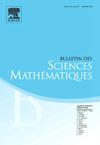Maximal functions of the multilinear pseudo-differentials operators
IF 0.9
3区 数学
Q2 MATHEMATICS, APPLIED
引用次数: 0
Abstract
In this paper, we consider the maximal multilinear pseudo-differential operator with symbols , and establish the estimate with a sharp bound . Our work improves the work of Chen, Dai and Lu [5] by extending the symbol σ from the Hörmander class to with . The main tools such as localizing the maximal pseudo-differential operators and the time-frequency analysis in [5] may not accommodate symbols with . In this work, we handle this difficulty by applying the inhomogeneous Littlewood-Paley-Stein decomposition to the space variable and using Taylor's expansion to track the size of those decomposed pieces. Then together with the ideas of using martingales, some related pointwise estimates and the good-λ inequality as in [16], [19], we will be able to obtain the boundedness with the optimal bound.
多线性伪微分算子的极大函数
本文考虑符号σ∈BS1,δ0(Rn×Rmn)的极大多线性伪微分算子,并建立了具有锐利界O(log (N+2))的Lp估计。我们的工作改进了Chen, Dai和Lu[5]的工作,将符号σ从Hörmander类BS1,00扩展到0≤δ<;1的BS1,δ0。[5]中的最大伪微分算子的局部化和时频分析等主要工具可能无法适应0<;δ<;1的符号σ∈BS1,δ0(Rn×Rmn)。在这项工作中,我们通过对空间变量应用非齐次littlewood - paly - stein分解并使用Taylor展开来跟踪这些分解块的大小来处理这个困难。然后结合使用鞅的思想,一些相关的点估计,以及[16],[19]中的good-λ不等式,我们就可以得到具有最优界的有界性。
本文章由计算机程序翻译,如有差异,请以英文原文为准。
求助全文
约1分钟内获得全文
求助全文
来源期刊
CiteScore
1.90
自引率
7.70%
发文量
71
审稿时长
6-12 weeks
期刊介绍:
Founded in 1870, by Gaston Darboux, the Bulletin publishes original articles covering all branches of pure mathematics.

 求助内容:
求助内容: 应助结果提醒方式:
应助结果提醒方式:


